December 9, 2013
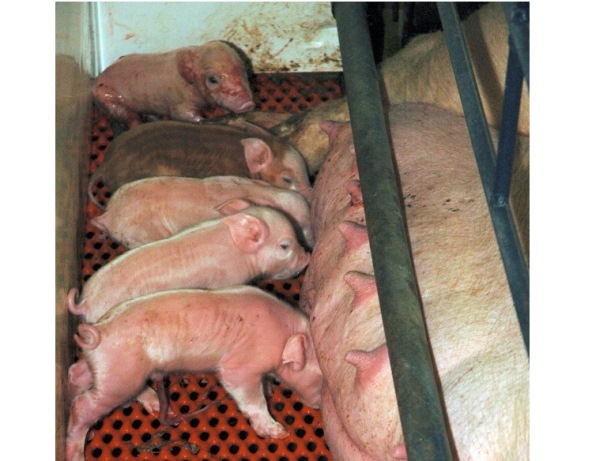
As we head into a period of high profitability for the pork industry, is your farm ready to take advantage of this by maximizing the number of quality pigs you can produce and sell? With iso-wean pigs being sold at $70.00+, hog futures near a carcass price of $100.00 per cwt., and feed costs dropping, how much more money could you make if you had fewer stillborns and lowered pre-weaning mortality percentages at your sow farm?
We decided to go back and revisit piglet survival numbers and make some suggestions on how your farm can be saving more pigs. Piglet survival is a number we developed a few years ago, based on this equation: 100% - stillborn % - pre-weaning mortality %. When working with this number we do not care how dead pigs are classified. Data from the Swine Management Services (SMS) database is shown in Table 1. When it comes to piglet survival, the average for all 601 farms for the last 52 weeks is 79.1% (See the “All” column in Table 1). The 61 farms making up the Top 10% of farms had 84.0% piglet survival.
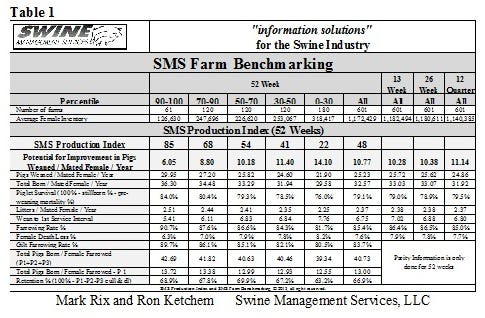
Table 1 provides the 52-week rolling averages for 11 production numbers represented in the SMS Production Index. The numbers are separated by 90-100%, the 70-90%, the 50-70%, the 30-50% and the 0-30%. We also included the 13-week, 26-week and 12-quarter averages. These numbers represent what we feel are the key production numbers to look at to evaluate the farm’s performance.
In Chart 1, “Piglet Survival,” you see data from 601 farms. The average is at 79.1% with farms ranging from less than 70% to top farms at greater than 90%. We have broken out Piglet Survival into stillborns and pre-weaning mortality. Chart 2, “Stillborns / Female Farrowed,” shows that farms range from less than 0.4 pigs per litter, to farms at greater than 1.4 pigs. The SMS average is 0.94 pigs. This shows the potential for saving at least 0.5 pig per litter with some farms at 1.0+ pigs. These are the pigs that need to be saved, since most are the bigger pigs with birth weights at 3+ pounds. We know that the number of stillborns increases as a female has more litters. In Chart 3, the data was broken out by parity from P1 to P7+. The black line in Chart 3 is the average by parity, with P1 at 0.75 pigs per litter and P7+ at 1.44 pigs. The top and bottom row represent the maximum and minimum numbers from the 601 farms. The minimum row shows that there are farms that are able to keep stillborns low with some management changes.
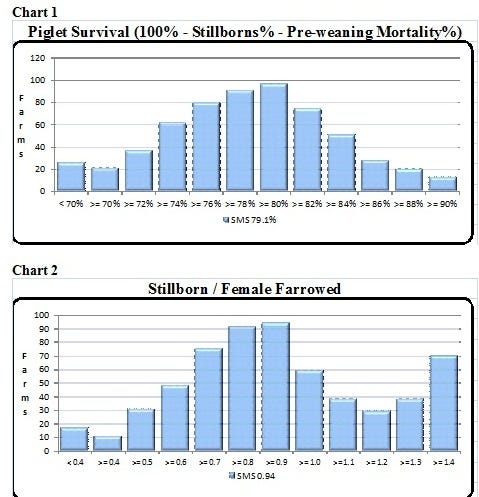
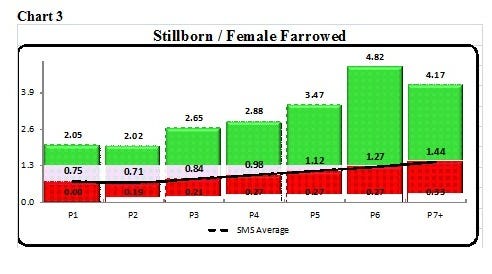
Here are some suggestions to lower the number of stillborns:
o Increase the number of hours someone is attending sows farrowing.
o Designate someone at the farm to be the Day 1 person who’s job is only working in the farrowing room to help sows and pigs.
o Train farrowing room personal how to identify sows that need assistance during farrowing.
o Show them the proper equipment and way to assist a sow with a farrowing problem.
o Identify females that have a history of stillborns, and spend extra time with them.
o Reduce the time between monitoring of sows from 30 minutes to 15-20 minutes after five pigs are born.
The other part of the piglet survival equation is pre-weaning mortality percentage. In Chart 4, “Pre-weaning Death Loss %,” you see the SMS average of 14.0%, with the best farms below 7%, and a large number of farms at 17.0+%. There are some farms in the database that have had health challenges over the last 52 weeks, but to be spending 52 weeks at 17.0+% pre-weaning death loss percentage needs attention. Over the last few years as the total pigs born / female farrowed has been increasing, the pre-weaning death loss has also gone up. What are the farms doing to lower this number and save more pigs in farrowing?
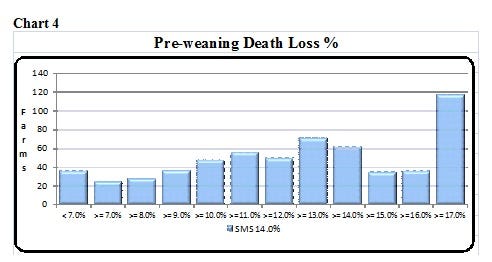
Here are some suggestions to help lower pre-weaning mortality:
o Designate a person or persons as Day 1 pig care specialists in the farrowing room, with the job of attending as many of the farrowings as possible.
o Extend the hours someone is in the farrowing room by adding a second or third shift so more litters are attended. If you can get someone in the farrowing room 18 hours per day, they can attend about 86% of the sows during farrowing.
o Have enough people in the farrowing room so sows can be checked at least every 30 minutes, and at 15-20-minute intervals on the last half of the farrowing process.
o Provide the Day 1 people with towels or buckets of drying agent so that pigs can be dried as soon as they are born. Make sure the pigs are placed near the udder, get attached to a nipple, and have access to a supplemental heat source. We feel the number-one cause of piglet deaths is chilled pigs.
o Make sure after the sow has farrowed that the litter is split suckled to help distribute the colostrum more evenly among the pigs, especially the pigs born late in the birth order.
o Complete cross fostering within the first 24 hours of life.
o Start checking and marking fallback pigs on Day 2, and place them on nurse sows or in rescue decks.
The key to saving more pigs in farrowing is to have caring people spending more time in the farrowing room, drying off pigs and assisting sows. This may mean your farm needs to hire more people for the farrowing area or cross train some of the current staff so on big farrowing days there are more people available to help save pigs in farrowing.
In looking at the big picture of production of pigs the USA, we look at the USDA numbers showing the US at 5,814,000 sows weaning an average of 10.38 pigs / litter, multiplied by 2.35 litters / sow = 141,820,902 pigs weaned per year. If piglet survival is at 79.0% the total number of pigs born is 179,520,129 pigs. Broken down by day that is 491, 836 pigs born / day which is 20,493 pigs born / hour. The 21.0% that do not survive adds up to 37,709, 227 pigs classified as stillborn or lost to pre-weaning morality. That equals 103,286 pigs / day or 4,304 pigs / hour. What would be the increase in income to the pork industry and your farm if changes were made to standard operating procedures when it comes to Day One management? What kind of results might you see if you trained your farrowing staff on the new Day One management, you added more staff in the farrowing room, and these changes improved the Day One piglet survival by 5%? Maybe you need to spend a few minutes doing the math.
Previous Production Preview columns can be found at www.nationalhogfarmer.com.
Keep the most in-depth pork production information available at your fingertips! Download our Blueprint app today.
You might also like:
Big Producers Make up Pig Losses with Heavier Weights
PED Virus Complicates Margin Management
Developing 11 Findings on Antibiotic Resistance
Are We Frittering Away Profit Possibilities to Keep Facilities Filled?
You May Also Like



